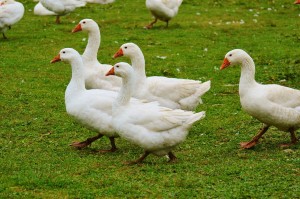
Twelve: Drumming muscles
 Some fish species have developed mechanisms that allow them to produce sounds and these species are known as drumming fishes. They use fast contracting muscles, known as drumming muscles, to produce sound and the rate of contraction sets the fundamental frequency of the sound.
Some fish species have developed mechanisms that allow them to produce sounds and these species are known as drumming fishes. They use fast contracting muscles, known as drumming muscles, to produce sound and the rate of contraction sets the fundamental frequency of the sound.
This study published in BMC Evolutionary Biology in particular focused on piranhas and aimed to determine the evolutionary lineage of such a characteristic.
Eleven: Cpipe pipelines

A software article from Genome Medicine reports the implementation of Cpipe. This is an exome analysis pipeline designed specifically for clinical genetic disease diagnostics. Its aim is to provide fast, effective and reproducible analysis, while also being highly flexible and customizable to meet the individual needs of diverse clinical settings.
This is vital, as clinical implementation of sequencing data becomes widespread there is a need for a freely available analysis platform that can be shared between clinical laboratories.
Ten: Land fish are leaping

The Pacific leaping blenny is a highly social fish that spends its adult life on land among the rocky foreshores of the island Gaum.
This BMC Evolutionary Biology study finds that there are changes in the phenotype of populations of this species with regards to the size of their head crest and the intensity of color on the red dorsal fin. These features are important for finding a mate and therefore divergence of such a reproductively important characteristic often leads to speciation.
This differentiation has occurred despite evidence of extensive gene flow among the populations, suggesting the change is recent. Regardless, this could ultimately form a barrier to reproduction between the populations, and eventually lead to speciation.
Nine: Ladies dancing
 Increasing the physical activity of children and adolescents has become an increasingly higher priority in order to prevent the risks of multiple diseases, such as heart disease, type 2 diabetes and cardiovascular disease, later on in life.
Increasing the physical activity of children and adolescents has become an increasingly higher priority in order to prevent the risks of multiple diseases, such as heart disease, type 2 diabetes and cardiovascular disease, later on in life.
For pupils, the school environment is one of the most important places this could be influenced, and this research published in International Journal of Behavioral Nutrition and Physical Activity aimed to introduce an after-school dance class for girls aged 11-12 as a way of increasing their physical activity.
Despite finding that it’s difficult to maintain the attendance of adolescent ladies (although this was reported to be due to factors outside of the dance lessons, and not just the teenagers ‘bunking off’), the article highlights that there is a need to find new ways to engage young women to be physically active.
Eight: Diabetes and milk(ing)
 The relationship between the consumption of different types of dairy and the risk of type 2 diabetes remains uncertain. This BMC Medicine study aimed to investigate exactly that – the association between dairy consumption and the incident of type 2 diabetes.
The relationship between the consumption of different types of dairy and the risk of type 2 diabetes remains uncertain. This BMC Medicine study aimed to investigate exactly that – the association between dairy consumption and the incident of type 2 diabetes.
Using food-frequency questionnaires, the diet of participants was assessed, and updated every four years. During the experiment, there were 15,156 incidents of type 2 diabetes cases documented. However there was no association between total dairy consumption and type 2 diabetes.
Despite this, results did show that yoghurt intake was consistently associated with a reduced risk of type 2 diabetes.
Seven: Swans are infected
 All known influenza A virus subtypes have been isolated from a number of species such as humans, pigs and horses. This study published in Virology Journal provides new information about the pathogenicity of a newly-isolated swan derived virus in birds and mammals.
All known influenza A virus subtypes have been isolated from a number of species such as humans, pigs and horses. This study published in Virology Journal provides new information about the pathogenicity of a newly-isolated swan derived virus in birds and mammals.
It was hoped that this would help identify key virulence or adaptation markers that can be used for global surveillance of viruses threatening to emerge in the human population.
Six: Geese toll-like receptors
 The role of toll-like receptors (TLRs) in the immune response to pathogenic bacteria and viruses have been studied intensively possibly due to their ability to recognize pathogens and initiate development of an immune response.
The role of toll-like receptors (TLRs) in the immune response to pathogenic bacteria and viruses have been studied intensively possibly due to their ability to recognize pathogens and initiate development of an immune response.
Currently, 13 TLRs in humans and 10 TLRs in chicken have been described but less is known about TLRs in geese.
The results published in BMC Veterinary Research suggest that one toll-like receptor in particular plays a role in the recognition of pathogen-associated molecular patterns in bacteria, particularly for Mycoplasma spp. Infections.
Five: Gold nanoparticles
 As nanomaterials are increasingly used in industrial and consumer products, workers and consumers are exposed to nanomaterials from multiple sources and via many routes.
As nanomaterials are increasingly used in industrial and consumer products, workers and consumers are exposed to nanomaterials from multiple sources and via many routes.
Inhalation is thought to be the primary route of exposure, after which, nanoparticles can deposit on the lung surface and be displaced where they can then interact with the epithelial cells.
This layer of cells, known as the air-blood barrier, forms one of the first cellular barriers of defence against inhaled nanoparticles. Great efforts have been made to determine the adverse health effects in the lungs caused by the inhalation and deposition of nanoparticles.
Using gold nanoparticles (as these have very low toxicity) researchers tested how such particles get through this barrier, and into other parts of the body, by combining both in vitro and in silico methods.
This novel technique, published in Particle and Fibre Toxicology, has the potential to replace short-term animal studies, and to serve as a screening tool to identify nanoparticles that may be more harmful than others.
Four: Calling birds
 Calling birds are also known as songbirds, and the chosen article for this fourth gift comes from Proteome Science which looks at the zebra finch songbird.
Calling birds are also known as songbirds, and the chosen article for this fourth gift comes from Proteome Science which looks at the zebra finch songbird.
I actually used to have three of these birds as pets, and I can tell you they definitely like a chirpy sing-song, but the focus of this article is on the mineralization of their eggshells. It is thought that this is controlled by the proteins in the eggshell matrices.
Most proteomic analysis has come from one avian family, the chicken. So this research looked at another family to try to understand the conservation of these proteins.
Three: Laying hens
 Feather pecking in laying hens is an abnormal behavior characterized by non-aggressive pecks directed towards the plumage of other hens. Although this behavior is well-known, it is still an unsolved problem in the industry as it increases mortality rates of hens.
Feather pecking in laying hens is an abnormal behavior characterized by non-aggressive pecks directed towards the plumage of other hens. Although this behavior is well-known, it is still an unsolved problem in the industry as it increases mortality rates of hens.
The researchers publishing in Genetics Selection Evolution aimed to conduct a genome scan to map selection signatures of hens. They used this to determine which model is the most advantageous to analyze such data on feather plucking behavior. Hoping to get to the bottom of this, and inform about why this characteristic has developed in selected laying hens, read more in their research article.
Two: Urban doves
 In order for a bird to tolerate an urbanized area, they must be able to tolerate multiple disturbances from humans. This Avian Research study investigated whether two long-term resident dove species were more tolerant to humans than a recent colonist pigeon species.
In order for a bird to tolerate an urbanized area, they must be able to tolerate multiple disturbances from humans. This Avian Research study investigated whether two long-term resident dove species were more tolerant to humans than a recent colonist pigeon species.
By comparing the Flight Initiation Distances and testing how far the birds would move away from a disturbing human, the researchers uncover how tolerant each species is of humans, and whether those that have lived there for longer have become used to such behavior, and hence are braver?
And a Ca2+ pathway in a Pear Tree
 Pear trees produce one of the world’s oldest fruit crop, yet like many other plants, they are at risk of salt stress. Such a limiting factor could reduce the plant productivity and affect the flavor and nutritional value of pear fruits.
Pear trees produce one of the world’s oldest fruit crop, yet like many other plants, they are at risk of salt stress. Such a limiting factor could reduce the plant productivity and affect the flavor and nutritional value of pear fruits.
Research has previously shown that calcium pathways are associated with the plants response to stresses, including that of high salt levels. This work from BMC Genomics aimed to uncover the molecular mechanisms that control the relationship between salt stress and calcium signaling pathways for pear trees.
Comments